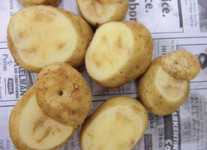Potato Pointers: In With The New: Zebra Chip

It’s not often that we come across a new disease of potatoes. I’m not talking about a new variant of a well-known disease like mefanoxam-resistant late blight or yet another strain of Potato Virus Y. No, I’m talking about something really new, something previously completely unknown. The Zebra Chip disease of potato is just such a new disease.
Zebra Chip was first identified in Mexico in 1994, where it was referred to as papa manchada, which means “stained potato.” The disease came to the attention of the U.S. chipping potato industry when problems began to occur on a fairly large scale in Texas in 2000. Since that time, it has been reported from another seven states and from Guatemala.
Losses occur because both foliage and tubers are adversely affected. Infected plants are purple and stunted as well as having thicker stems and smaller leaves. Aerial tubers can also form. By far the most significant damage occurs in the tubers where changes in the reducing sugar/starch ratios in various
regions of the tuber yields potato chips with dark “zebra” stripes. This same tuber defect can also cause problems for fresh pack producers. Losses have been significant since the original finding and an intense search for the cause of the problem was soon underway.
Finding The Culprit
Initial investigations focused on the possible role of an insect, the potato psyllid. These pests were not only present in many of the problem fields, but they are also known to cause growth irregularities (psyllid yellows) because of toxic materials they produce during the nymph stage of their life cycle. Subsequent testing showed that psyllids were probably involved in some way, but were not the direct cause of the problem. The research emphasis shifted. If the psyllid wasn’t the direct cause, could it be acting as a “vector” for some other disease organism?
The search for the Zebra Chip organism got a much-needed boost when a very similar disease turned up in tomatoes and peppers in New Zealand greenhouses in January of 2008 and was subsequently found in field grown potatoes a couple of months later. The New Zealanders identified a previously undescribed subspecies of an obscure group of bacteria called Candidatus Liberibacter in association with their new disease.
Other members of this small and poorly studied group of bacteria are known to cause citrus greening in Asia and Africa and, more importantly, are known to be vectored by psyllids. With the psyllid vector as the common factor, PCR (polymerase chain reaction) probes for the bacterium, developed by the New Zealand group, were made available and utilized to positively identify the new pathogen in U.S. Zebra Chip potato samples in late 2008.
As a group, these bacteria are very difficult to work with. Knowledge about them is not widespread. They are restricted to the vascular (phloem) tissues of the plant and are what we call “fastidious,” meaning they can’t be grown in culture. These and other factors added an enormous degree of difficulty to the search.
Finding the causal agent of Zebra Chip took about eight years and the efforts of several research groups as well as industry and government involvement. The search wasn’t nearly as straightforward as it might seem from this brief outline. A description that covered all the frustrating dead ends and red herrings that the scientists encountered during their investigations would require a fairly lengthy treatise, maybe even an entire book. In the scheme of things, this is really pretty good progress, especially given the obscure nature of this group of bacteria and the difficulty in working with them.
Now all that remains is figuring out how to manage the problem. Obviously, knowing what is causing the disease is a huge step in the right direction. Management recommendations are currently being formulated and will probably target the psyllid vector in some way. Naturally, additional studies will be necessary.










